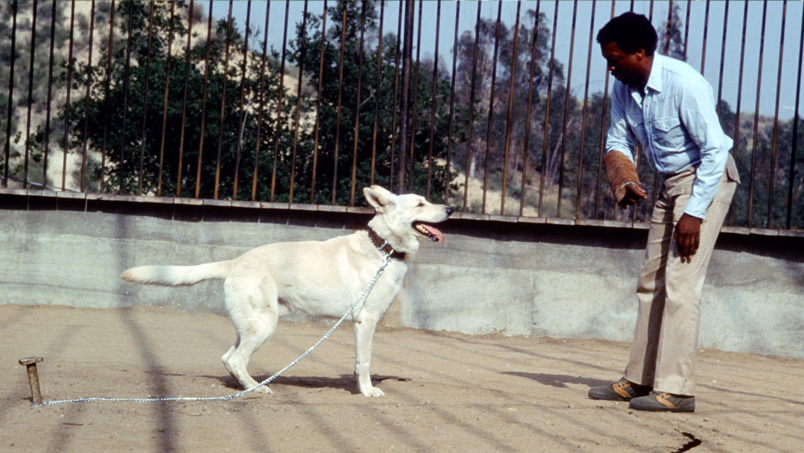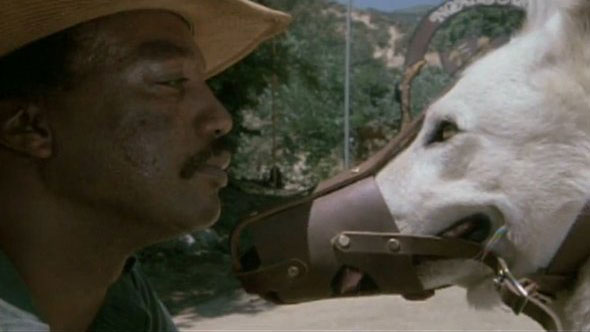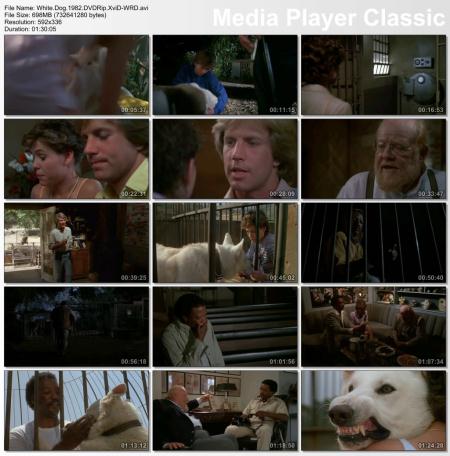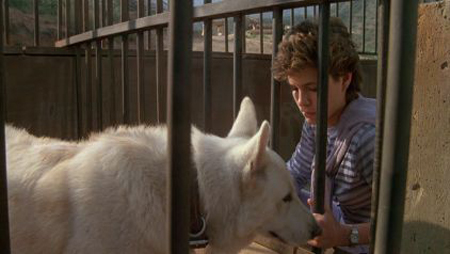From the Chicago Reader (November 29, 1991). — J.R.
WHITE DOG **** (Masterpiece)
Directed by Samuel Fuller
Written by Fuller and Curtis Hanson
With Kristy McNichol, Paul Winfield, Burl Ives, Jameson Parker, Lynne Moody, and Marshall Thompson.
The best American movie released so far this year, made by the greatest living American filmmaker, was actually made ten years ago, and so far its venues have been restricted to single theaters in New York and Chicago; but late is a lot better than never, and two cities are certainly better than none. Why it’s taken a decade for Samuel Fuller’s White Dog to reach us is not an easy question to answer; it was shown widely in Europe in the early 80s and well-received critically. For the past few years it has turned up sporadically on cable, principally the Lifetime channel, but it has never come out here on video. White Dog started out as an article by Romain Gary published in Life magazine, and was later expanded into a book. The accounts I’ve read describe the book as autobiographical, mainly about the author’s relationship with Jean Seberg. Gary and Seberg were living in Los Angeles when they found a “white” dog who had been trained to attack blacks; they tried without success to have the dog retrained, and eventually had to kill it. Gary’s book also deals with Seberg’s involvement with the Black Panthers and the FBI’s subsequent persecution of her, which eventually led to her suicide; Gary himself committed suicide some time afterward, and Fuller’s film is dedicated to him.
The rights to White Dog were purchased by Paramount in the mid-70s, and Roman Polanski briefly planned to make a film derived from it after Chinatown. But eventually Don Simpson, in charge of production at Paramount in the early 80s, inherited it; he put together a group of film projects that were designed to be made cheaply (the most commercially successful of which proved to be An Officer and a Gentleman), and White Dog was among them. The project went through several phases; at one point Top Gun‘s Tony Scott was set to direct it, and at another it was planned as a vehicle for Jodie Foster. At least one of the various plans conceived of the film as a sensationalist venture, and when gossip about it leaked out the NAACP lodged a protest, believing — perhaps with some justification — that the film could foster racist violence by inspiring rednecks to train “white dogs.” That protest tarnished Fuller’s masterpiece when it finally came to be made, despite the fact that it remained unseen by its accusers and is anything but racist or incendiary.
When people over the years have alluded to the film as being “controversial,” they more than likely have been sharing and perpetrating this misunderstanding. When Jon Davison, the producer of Airplane!, was first assigned to the project, he reportedly didn’t want any part of it. Then he had the brilliant idea of assigning Fuller to the project. Fuller completely rewrote the script with Curtis Hanson, a friend of his who had already worked on one of the earliest drafts; apart from some of the characteristics of the dog Gary described and the white man who ran the animal training compound, all of the Gary book was jettisoned. Instead, the story focused on a white actress who finds the dog and a black animal trainer who tries to recondition him. After the film was completed, it was briefly test-marketed, tampered with a bit but not significantly altered by the studio, released overseas, and then essentially shelved. Not long afterward Fuller moved to Europe, where he has lived and worked ever since. The move was understandable considering the studio treatment accorded his last two American pictures: four-hour and two-hour cuts of The Big Red One (1980), his magnum opus about his World War II experiences, were both discarded in favor of a drastically reworked version that wound up pleasing no one (although it is full of extraordinary and beautiful moments even in this form), while White Dog was never released domestically at all. Since Fuller’s move to Paris, apart from writing several novels and appearing in several films, he has written and directed three more features and one short film — a Patricia Highsmith adaptation for French TV that I haven’t seen — none of which has opened in the U.S.
He is currently 79, and his chances of working again for an American studio are extremely slim, though he still harbors hopes that his original four-hour cut of The Big Red One might be restored, even if only for a French miniseries. In Paris he’s still a celebrity; many of his novels have appeared in translation (most recently The Big Red One, though it retains its English title) and his movies are regularly revived in theaters. In this country, very few people under 30 seem to know he exists, even though he’s as American as apple pie and the uncontested godfather of filmmakers as diverse as Jean-Luc Godard, Steven Spielberg, Martin Scorsese, Wim Wenders, and Peter Bogdanovich. (A few examples of his influence: Fuller collaborated on the story of Bogdanovich’s first film, Targets. He appears in Godard’s Pierrot le fou, Spielberg’s 1941, and three Wenders features. There’s a clip from his Pickup on South Street in Scorsese’s The King of Comedy, and extended hommages to other Fuller films in Godard’s Breathless and Spielberg’s Indiana Jones and the Temple of Doom.) Given his eclecticism, it’s highly unlikely that he’ll ever get an Oscar or an American Film Institute Lifetime Achievement Award; in spite of his major importance, his name has never really registered in the American mainstream. As a novelist and screenwriter, he’s unabashedly pulpy, a street prole who writes in short, lurid sentences. On the other hand, he’s too full of didactic notions, most of them historical or political, to make it into the current postmodernist pantheon shared by writers like Jim Thompson. Bursting with goofy and exaggerated ideas, his pictures are frontal assaults of explosive conceptual energy that can rarely be rationalized on a naturalistic level. (His brilliant Shock Corridor, set in an insane asylum, tells us less than nothing about the mentally ill but practically everything about what’s wrong with America in 1963.)
A master at depicting violent action, Fuller has a particular flair with both close-ups and long takes, a formal brilliance he exhibited a full decade and a half before any American critic besides Manny Farber recognized the presence of such methods in either Fuller’s cheap genre pictures or anyone else’s. The brutish and loutish heroes of most of his pictures tend to be too unromantic to serve as identification figures, but they don’t fall into predictable antihero slots, either. (His films are seldom devoid of tenderness, but nearly all of it in his earlier pictures is accorded to children and other victims of adult corruptions.) After critics inaccurately typecast Fuller as a primitive cold warrior and red-baiter — mainly on the basis of the spy thriller Pickup on South Street (which incidentally won the Bronze Lion at the 1953 Venice film festival with the full support of Luchino Visconti, a communist who headed the jury) — they found it increasingly difficult to deal with or even recognize the radical social critiques of American life present in his work. Even in The Steel Helmet, the first Korean-war film, made three years before Pickup, the best ideological points are scored by a Korean communist who lectures a black American GI about segregation on buses and a Japanese American GI about the American concentration camps during World War II — two matters that no other American filmmaker was dealing with in 1950. The Korean communist may be a “villain,” but in contrast to the thuggish and racist American “hero,” who eventually goes completely haywire, he’s positively charismatic. Where Fuller differs most strikingly from his acolytes is that he lived the equivalent of two entire lives before he ever got around to making movies–one as a crime reporter and one as a much-decorated war hero. (He directed his first feature, I Shot Jesse James, in his mid-30s.) He has a lot to say about both subjects — about war in The Steel Helmet, Fixed Bayonets, Hell and High Water, China Gate, Verboten!, Merrill’s Marauders, Shock Corridor, and The Big Red One, and about crime in Pickup on South Street, House of Bamboo, Underworld, U.S.A., and The Naked Kiss. But this list hardly exhausts the range of his street smarts. Forty Guns is one of the wildest westerns ever made, and Park Row is the giddiest celebration of American journalism after Citizen Kane. Fuller films as diverse as The Steel Helmet, Run of the Arrow, China Gate, The Crimson Kimono, Shock Corridor, and White Dog are arguably the most trenchant — and in some cases the most prescient — treatments of racism in the American cinema.
Is it possible to remove hatred from the world? If racism is a form of conditioned hatred, is it possible to eradicate it through reconditioning? Does reconditioning itself entail a kind of violence that threatens sanity and emotional equilibrium? These are some of the questions addressed by White Dog, and while the conditioning and reconditioning in this case is done to a German shepherd, Fuller never lets us forget that it’s humans, not animals, who are at issue. As in the fables of Aesop and La Fontaine, the hero of Fuller’s parable may be a dog, but the subject is the human race. The nameless title hero of the film is a dog trained to attack blacks, and then retrained during the film to overcome this conditioning by a black man named Keys (Paul Winfield) who’s a professional animal trainer. The dog is a tragic scapegoat, neither racist nor antiracist in any human sense. He certainly inspires us to reflect on how conditioning can foster racism, but his own “racism” is purely man-made. We’re told how the conditioning of white dogs is usually carried out: a black wino or junkie is paid by the dog’s owner to beat the dog mercilessly and repeatedly as a puppy, and a proclivity for attacking blacks grows out of the resulting trauma.
Julie Sawyer (Kristy McNichol), a young actress who lives in the Hollywood Hills surviving on bit parts, accidentally injures the dog one night in her car, takes him to a vet, and then brings him home, hoping she can locate the owner. After no owner materializes and she gradually becomes aware that he’s an attack dog, she takes him to a compound called Noah’s Ark, where animals are trained for movies and commercials, in the hopes that the dog can be deprogrammed. While the co-owner of the compound (Burl Ives) sadly informs her “Can’t nobody unlearn a dog” and advises her to have him killed, Keys agrees to do his utmost to reverse the dog’s training, and the remainder of the film is devoted to the intense and heartbreaking drama of this process.





